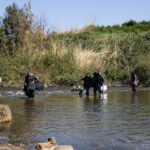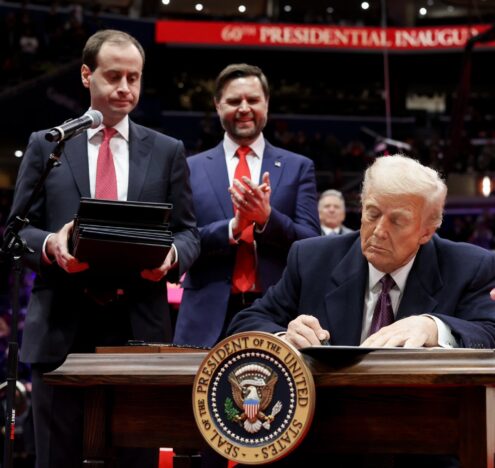May 2023 was a big month for Arctic security, or the “High North” territories of Nordic countries located above the Arctic Circle. In early May 2023, Norway took over as chair of the Arctic Council from Russia despite a frozen diplomatic relationship due to the invasion of Ukraine. Subsequently, a flurry of activity seemed to pivot northward.
On May 24, 2023, the world’s largest warship, the USS Gerald Ford, visited the Oslo Fjord on its inaugural deployment marking the first visit of a US aircraft carrier to Norway’s capital since 1958. The American ship integrated Norwegian capabilities, demonstrating a unique US-Norway interoperability that sought to “enhance” the partnership between the two countries. Following the Oslo visit, the ship sailed north past the Arctic Circle to participate in one of Europe’s largest-ever live air exercises. The “Arctic Challenge Exercise” was led by Finland, NATO’s newest member as of April 2023. While not explicitly a designated NATO exercise, the alliance had a clear role: The Naval Striking and Support Forces of NATO claimed their participation was to signal “NATO’s credibility of collective defence and deterrence.”
The difference between the Norwegian government’s support for US and NATO military assistance and civil society concerns about crisis escalation point to a unique challenge Nordic countries must address as they take a policy spotlight.
Around this same time, back on land in Oslo, Norway hosted an informal meeting of NATO Ministers of Foreign Affairs. The meeting centered around providing long-term civilian and military support to Ukraine. Notably, it included NATO invitee Sweden in the discussions, with strong support voiced for the country’s full membership. Despite the Ukraine focus, the Norwegian Minister of Foreign Affairs Anniken Huitfeldt stressed the importance of Norwegian military presence in the High North to follow Russian military activity. Similarly, continuing the theme of US-Nordic partnerships, Secretary of State Antony Blinken visited Sweden, Norway, and Finland during this same timeframe, emphasizing “transatlantic priorities” including “technology cooperation” and “strong bilateral relationship[s] with…NATO [allies].” Blinken also announced that the United States would open a diplomatic station in Norway above the Arctic Circle, while President Joe Biden signed NATO membership protocols for Finland and Sweden.
This 2023 pivot North marks a distinct difference in US policy objectives from the last time I wrote about Nordic countries for Inkstick. In 2018, the last time a US aircraft carrier visited the Arctic Circle, bilateral and multilateral alliances in the High North were much more “frosty.” Unlike the Biden administration, the Trump administration was more intent on mocking the economic systems of Nordic countries while at the same time increasing demands for defense burden-sharing. Given the change within the US government and the drastic change in the security environment in Europe following the wake of the Ukraine invasion, one thing is clear: High North security and geopolitics are now a predominant policy priority.
Is There Such a Thing as an Easy Ally?
As an American living in Oslo, my Norwegian friends always like to tell me that Norway “is an easy ally.” Indeed, Norway is home to the most NATO installations above the Arctic Circle, and NATO participation is a cornerstone of Norwegian foreign policy. However, not everyone was impressed with the strong US and NATO presence on Karl Johans Gate this past month. Around the city, several posters instructing the American sailors to “go home” claimed US military presence in Norway was “increasing the risk of nuclear war.”
The difference between the Norwegian government’s support for US and NATO military assistance and civil society concerns about crisis escalation point to a unique challenge Nordic countries must address as they take a policy spotlight. Nordic countries must balance meeting evolving alliance commitments while simultaneously reducing the risk of Russian aggression along their Arctic borders. Namely, given Europe’s rapidly changing security environment, it is imperative that Nordic countries balance cooperation and competition to prevent geopolitical instability.
As a founding NATO member with a history of tricky relations with neighboring Russia, Norway can serve as a policy blueprint for its Nordic neighbors, Finland and Sweden, as they join NATO. Norway has historically embraced a strategic policy of balancing deterrence and reassurance. That is, Norway seeks to both deter Russia from aggressive geopolitical maneuvering in the North and simultaneously prevent crisis escalation by restricting US and NATO presence near the Russian border. Norway has recently reiterated this commitment to strategic balancing in its foreign policy objectives above the Arctic Circle, stating “high north, low tension” remains a key objective for the country moving forward.
Given Russia’s invasion of Ukraine, US support of military activity in the High North, and recent changes in NATO alliance memberships, the balance between deterrence and reassurance in the High North has grown increasingly difficult to achieve despite its clear importance for strategic stability. Geopolitical trade-offs for stability require both competition and cooperation to be successful. However, the distinct diplomatic freeze between Russia and its High North neighbors makes cooperation less than attainable.
Should new NATO states like Finland and Sweden seek to emulate Norway’s security policy as they enter the alliance, it is crucial that competition is successfully managed to prevent crisis escalation. Given Russian geopolitical interest in competition over cooperation, the United States can have an important role in facilitating a strategic balance within the High North. For example, by assisting the Nordic countries militarily, but simultaneously ensuring the Nordics are taking the lead in joint operations and exercises, the United States can help the Nordics signal a strategic deterrence-reassurance balance that might not otherwise be effectively communicated to Russia in an era of frozen diplomatic relations. While not explicitly discussed in US policy as of yet, this type of US-backing with a Nordic lead can clearly be seen in the recent “Arctic Challenge Exercise.” In a European security context that lacks Russian cooperation, High North deterrence and reassurance balances can best be made possible through effectively communicating alliance management and continued partnership.
A Lukewarm Welcome
While the USS Gerald Ford was in port, some American sailors and I had a beer (or two) in a bar downtown Oslo. As we were speaking, a Norwegian woman approached us and claimed, “Look, we are happy you are here, but we hope to never need you.” And the sailors full-heartedly agreed. Perhaps less eloquent than formal policy proposals, I believe this sentiment speaks to the heart of US-High North dynamics moving forward.
To manage increasingly complex geopolitical situations characterized by icy diplomatic relations on one front and an increased desire for partnership on the other, risk reduction can best be achieved by first acknowledging the innate challenge of a Nordic security trade-off. Stability in the High North requires juggling multiple agendas to balance competition and cooperation delicately in constantly evolving security contexts. It is clear the US and NATO have established stakes in the High North — stakes that are unlikely to be pulled up in the coming years, but stakes that nonetheless will hopefully never evolve from deterrence to conflict mobilization.




















